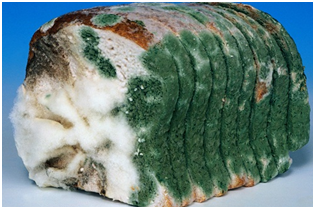The study of pathogenic fungi (i.e. fungal organisms that are of medical importance) is known as medical mycology. Pathogenic fungi are fungal organisms that cause disease in humans. Human mycoses may include infections of the outer skin layer, infections of the underlying tissues of the skin, systemic infections, and deep-seated infections or invasive mycoses. Other fungal infections are opportunistic in nature, and they rarely affect individuals whose immune system is still intact. Opportunistic mycoses usually occur in immunocompromised individuals such as HIV/AIDS patients as well as in people with debilitating diseases like cancer. Fungal organisms are major spoilage organisms of foods and other food products. Pathogenically, fungal infections can be exogenous or endogenous in nature.
In exogenous fungal infections, the fungal infection is usually acquired externally from the environment via the inhalation of fungal spores in aerosols or dust particles. Infectious conidia or spores of fungi are ubiquitous in the environment especially in the soil, and they can easily cause human infection through inhalation. Inhalation of fungal spores in large doses can predispose humans to a variety of fungal infections. Fungi that cause exogenous infections in man penetrate the body via the respiratory tract system from where they reach the lungs to cause systemic or deep mycoses.
Endogenous fungal infections are caused by fungi that are members of the human normal microflora (e.g. Candida species). Infections caused by endogenous fungi usually occurs when the body’s immune system is compromised or in a bad condition. Most fungal infections are restricted to a particular geographical area while others are distributed worldwide in the environment. The main portals of entry of fungi that cause exogenous mycoses include the normal microflora of the skin, mouth, GIT and the vagina. It is noteworthy that most fungal infections especially those caused by dermatophytes and even some endogenous mycoses are best prevented via an intact host skin which prevent pathogen entry from the outside.
Good personal hygiene is also essential in preventing some fungal infections (e.g. dermatophytosis). However, a broken or injured skin is the common sites and portal of entry for environmental fungi to enter the body and become established. Fungal organisms elaborate both beneficial and non-beneficial effects in the natural environment. Beneficial fungi have been exploited by man since time immemorial to produce food, drugs and other products that are of economic and health importance. However, some fungal organisms termed as non-beneficial fungi cause a wide range of infections and diseases in human populations, as well as in plants and animals; and fungal organisms cause a variety of food spoilage which amount to great economic loss to food production companies (Figure 1).

References
Anaissie E.J, McGinnis M.R, Pfaller M.A (2009). Clinical Mycology. 2nd ed. Philadelphia, PA: Churchill Livingstone Elsevier. London.
Beck R.W (2000). A chronology of microbiology in historical context. Washington, D.C.: ASM Press.
Black, J.G. (2008). Microbiology: Principles and Explorations (7th ed.). Hoboken, NJ: J. Wiley & Sons.
Brooks G.F., Butel J.S and Morse S.A (2004). Medical Microbiology, 23rd edition. McGraw Hill Publishers. USA.
Brown G.D and Netea M.G (2007). Immunology of Fungal Infections. Springer Publishers, Netherlands.
Calderone R.A and Cihlar R.L (eds). Fungal Pathogenesis: Principles and Clinical Applications. New York: Marcel Dekker; 2002.
Chakrabarti A and Slavin M.A (2011). Endemic fungal infection in the Asia-Pacific region. Med Mycol, 9:337-344.
Champoux J.J, Neidhardt F.C, Drew W.L and Plorde J.J (2004). Sherris Medical Microbiology: An Introduction to Infectious Diseases. 4th edition. McGraw Hill Companies Inc, USA.
Chemotherapy of microbial diseases. In: Chabner B.A, Brunton L.L, Knollman B.C, eds. Goodman and Gilman’s The Pharmacological Basis of Therapeutics. 12th ed. New York, McGraw-Hill; 2011.
Chung K.T, Stevens Jr., S.E and Ferris D.H (1995). A chronology of events and pioneers of microbiology. SIM News, 45(1):3–13.
Germain G. St. and Summerbell R (2010). Identifying Fungi. Second edition. Star Pub Co.
Ghannoum MA, Rice LB (1999). Antifungal agents: Mode of action, mechanisms of resistance, and correlation of these mechanisms with bacterial resistance. Clin Microbiol Rev, 12:501–517.
Gillespie S.H and Bamford K.B (2012). Medical Microbiology and Infection at a glance. 4th edition. Wiley-Blackwell Publishers, UK.
Larone D.H (2011). Medically Important Fungi: A Guide to Identification. Fifth edition. American Society of Microbiology Press, USA.
Levinson W (2010). Review of Medical Microbiology and Immunology. Twelfth edition. The McGraw-Hill Companies, USA.
Madigan M.T., Martinko J.M., Dunlap P.V and Clark D.P (2009). Brock Biology of Microorganisms, 12th edition. Pearson Benjamin Cummings Inc, USA.
Mahon C. R, Lehman D.C and Manuselis G (2011). Textbook of Diagnostic Microbiology. Fourth edition. Saunders Publishers, USA.
Discover more from #1 Microbiology Resource Hub
Subscribe to get the latest posts to your email.



